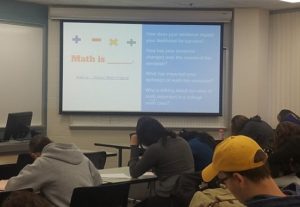- MN ABE Connect
- Archive
- Why I Started Focusing on Soft Skills in My Math Class, and Why You Should Too: PART 1
 November 13, 2018
November 13, 2018
Why I Started Focusing on Soft Skills in My Math Class, and Why You Should Too: PART 1
Amber Delliger, Instructor / ATLAS Numeracy Advisory TeamOver the past 13 years I have worked with math students of all ages, from kindergartners, to a great grandmother working towards her GED, to veteran teachers working to improve numeracy instruction in their own classrooms. My current teaching assignment is at Anoka Ramsey Community College working on a pilot class to help improve success and retention of college students who place into developmental math courses.
I spend my week teaching beside a college instructor and a professional tutor in an accelerated beginning/intermediate algebra course we call Mathematical Foundations with Elementary Algebra. This is a course that covers two semesters of math content condensed into one semester with required college faculty-led and Adult Basic Education (ABE)-led class sessions. With the help of my colleagues, we have developed a course that attempts to balance the traditional college lecture experience and the small group/personal learning plans of ABE.
Addressing Gaps in Skills
When we started our project over a year ago, we anticipated that as the ABE support, I would be spending the majority of my time pre-teaching, re-teaching, and filling in content gaps. While this makes up a good chunk of my instructional time, a much more pressing need has arisen.
The students we are working with do have your expected skill gaps: division, working with decimals and fractions, and navigating word problems, but these are not the only skill gaps that are holding them back.
 Over the past 3 semesters, what we learned was that many of our students lack the fundamental skills that enable them to be successful independent learners in the math classroom and beyond. The students were struggling to take adequate notes, navigate their textbooks, develop effective study strategies, complete their homework assignments… the things that often spell disaster for students. It was clear that there wasn’t mal-intent from any of the students – they weren’t sitting in class staring blankly at us (or their cell phones) because they wanted to “stick it to us” – but instead, they weren’t sure when information was key, or how to record the right information to help them later when they were outside of class.
Over the past 3 semesters, what we learned was that many of our students lack the fundamental skills that enable them to be successful independent learners in the math classroom and beyond. The students were struggling to take adequate notes, navigate their textbooks, develop effective study strategies, complete their homework assignments… the things that often spell disaster for students. It was clear that there wasn’t mal-intent from any of the students – they weren’t sitting in class staring blankly at us (or their cell phones) because they wanted to “stick it to us” – but instead, they weren’t sure when information was key, or how to record the right information to help them later when they were outside of class.
After feeling frustrated from watching students not perform to their potential, and watching them struggle with their own frustrations, we decided to lean more heavily onto purposefully incorporating soft skills instruction into our daily curriculum. Just having discussions about and reflecting on the soft skills required to be successful in college wasn’t enough. We turned to the Transitions Integration Framework identified in Minnesota’s Adult Education Academic, Career, and Employability Standards (ACES). These standards define the academic, career, and employability skills that are essential for students to successfully transition to post-secondary education, career training, the workplace, and community involvement.
Now, our daily learning targets include mathematic content and a targeted soft skill. In each lesson, we share learning targets with our students that highlight all the skills we are hoping to develop that day. We also utilize exit tickets, journaling, or other reflection activities that ask students to identify how or when they are using their skills and if it is helping them feel more successful in the classroom.
For example, it is nearing the end of the semester and students need to start thinking about creating a plan to prepare for their finals. Students were asked to pull out their calendars and syllabus turn ensure all future tests, including the final which is at a different time than our normal class, were marked down. Then, students journaled about 3 successful study strategies that they have employed during the semester. Looking at their upcoming tests and thinking about the study strategies they prefer, students wrote out a plan on how to balance studying for future tests and the final at the same time. We will be checking in with these journals later in the semester to check in on their progress and adjust their plans as necessary.
Study Skills We Incorporated from the Beginning
From the beginning of the pilot, we knew basic soft skills instruction would be helpful. We had class visits from many available campus resources (TRIO, Advising, Counseling, Disability Services, Math Skills Center, etc.). Our hope was to help students make face-to-face connections with the programs that would provide support not only during this course, but throughout their program. We also did mini-lessons throughout the first three weeks of school on specific study skills (note taking, studying, test anxiety, navigating the math textbook) to set the stage for long-term success. Our plan was to continue to support these skills throughout the semester through a variety of planned reflective activities.
Examples of Soft Skills We Added After Seeing the Deficit
- Develop growth mindset norms for the classroom and hold everyone in the room to them (Navigating Systems)
- Discuss expectations for discussion and participation and WHY/HOW that fits into our norms (Self-Management) (Effective Communication)
- Explore attitudes about math and math autobiographies (Learning Strategies) (Critical Thinking)
- Meet representatives from targeted on campus resources to help address common exterior barriers (Navigating Systems)
- Model note taking techniques and provide targeted feedback about notes (Learning Strategies)
- Discuss and model studying strategies (Learning Strategies)
- Write about and reflect on goal setting before/during/after testing cycles (Self-Management) (Effective Communication)
- Offer opportunities to discuss mistakes (type, causes, misconceptions) (Critical Thinking) (Effective Communication)
- Support the creation of long term goals and provide resources/connections to resources to help stay on track for these goals (Self-Management)
- Practice close reading strategies using the class syllabus and mathematics text (Learning Strategies)
- Provide learning tasks that require students to use a variety of resources including digital and interpersonal (Learning Strategies) (Critical Thinking)
- Develop study groups/routines that are student driven to help transition them to other study resources (Learning Strategies) (Self-Management)
- Hold students to high standards as indicated in the syllabus (Navigating Systems) (Effective Communication)
What We’ve Learned So Far
We have learned so much through these efforts! To find out what we’ve learned and how you can apply this to your own setting, see Part 2 of this article!
Want to learn more about ACES? Check out the ACES Resource Library on the ATLAS website.

Newsletter Signup
Get MN ABE Connect—the official source for ABE events, activities, and resources!
Sign UpArticle Categories
- ABE Foundations/Staff Onboarding
- ACES/Transitions
- Adult Career Pathways
- Assessment
- CCR Standards
- Citizenship
- COVID-19
- Cultural Competency
- Digital Literacy/Northstar
- Disabilities
- Distance Learning/Education
- ELA
- Equity/Inclusion
- ESL
- HSE/Adult Diploma
- Listening
- Math/Numeracy
- Mental Health
- Minnesota ABE
- One-Room Schoolhouse/Multilevel
- Professional Development
- Program Management
- Reading
- Remote Instruction
- Science
- Social Studies
- Speaking/Conversation
- Support Services
- Teaching Strategies
- Technology
- Uncategorized
- Volunteers/Tutors
- Writing